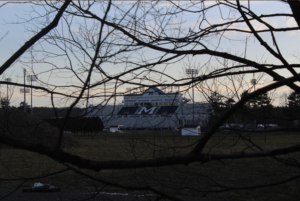Maine has an abundance of beauty. It is known for Acadia National Park, the crown jewel of the North Atlantic Coast. Mount Katahdin, Maine’s tallest peak, invites tourism in heaps to hike and enjoy its excellence. So much love for Maine and appreciation for its natural wonders — but how much love is too much?
On Monday, Nov. 27, 2023, Aislinn Sarnacki, an outdoor journalist for the Bangor Daily News, lectured about conservation in Maine. A born and raised Mainer, Sarnacki is an alumnus of the University of Maine who graduated in 2010. Before her decade working for Bangor Daily News, Sarnacki got her start as a journalist for The Maine Campus.
Over the past ten years, she has explored the wilderness and trails of Maine, cultivating her weekly columns, writing three hiking guidebooks and increasing her knowledge of the natural landscape. In this lecture, she discussed the impending fears around popular natural areas, specifically Katahdin and Acadia.

“Loving the wilderness to death: that is what we are doing, especially in the national parks, our more popular state parks. Katahdin is one of the places we are concerned about. In Maine, we have a couple of really popular spots. Katahdin is one of them. There is a high demand to hike Maine’s tallest mountain. How do we spread people out?” Sarnacki said.
Sarnacki’s goal, amongst many others in this field of conservation, is to limit the amount of overpopulation in given areas. More visitors in condensed wildlife zones have critical effects on the natural environment: resource damage, environmental degradation, noise pollution, and other problems that disrupt the habitats. Naturally, the most popular areas are experiencing the most turmoil. As she states, “In Maine, Acadia has seen a market increase in visitation in recent years. Baxter State Park [has seen] the same thing.”
Sarnacki’s mission is to show people a more broad, diverse arraignment of trails and sights throughout Maine to address overcrowding. Through her books, columns, and social media, Sarnacki pushes hikers to spread out to other trails, hike in the off-season and to be educated on “leave no trace” practices. All of these methods mitigate overcrowding. Sarnacki highlights the importance of individual change.
“Through a conservation perspective, people are who are conserving and saving the world, just as we are also destroying it. So we have to also conserve it. It is up to us. On an individual level, it takes people who care. In order to care about the wilderness, I think people need to spend time in it. Fall in love with it. Forge connections with it,” Sarnacki said.
Before greater change can happen, people on a smaller, individual scale must take heed in their actions. This idea that Sarnacki discusses is tied closely to “leave no trace,” an environmental idea made up of seven principles (plan ahead, travel and camp on durable surfaces, dispose of waste properly, leave what you find, minimize campfire impact and being considerate of other visitors) that minimize the impacts of time outdoors. From individual action to population, Sarnacki hopes for Maine’s natural beauty to be loved in a way that does not cause harm.













